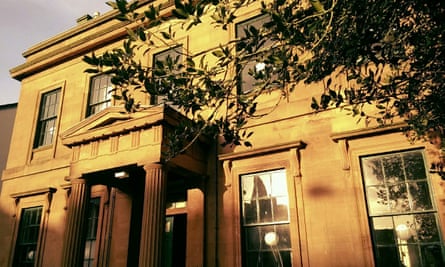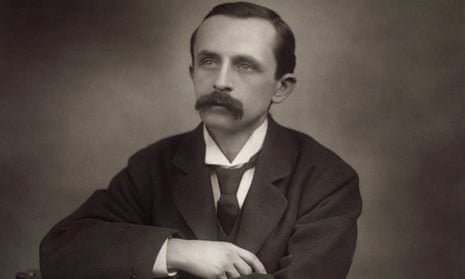Neverland, the magical place made famous by JM Barrie’s Peter Pan, will be closer than you think this Christmas – not just for lost boys but for grown-ups as well. The enchanting garden in Scotland that gave Barrie the idea for his classic children’s story also later inspired him to write another play, this time placing a group of fictional adult characters alone in a beautiful natural environment. And now the little-known work, Dear Brutus, is to be revived on the London stage for the first time in more than 20 years.
In a time of austerity and hard political challenges, the director of the play believes the British public’s need to escape to the solace and freedom of a magical world could not be greater. “Although the concerns of Barrie’s audience were different, they probably felt very similar in terms of their anxiety. Our audience, in the middle of fears about terrorism and politics, I am sure really want to escape the world around them,” said Jonathan O’Boyle, director of Dear Brutus, which opens at Southwark Playhouse on 29 November.
“This play was written over a decade after Peter Pan. It was performed in 1917 and written the year before, so the kind of enchanted world Barrie created served a different purpose. By then he had seen the impact of war and his marriage had broken down. So, in this mood, he wanted to write a comic fantasy for adults, with much darker concerns. It does create a Neverland for grown-ups because Act 2 is set in an English wood that offers a mysterious second chance for his eight central characters. It is the kind of transformative natural environment we see in Shakespeare’s plays, such as A Midsummer Night’s Dream.”
Barrie’s enchanted forest is inhabited by an elderly Puck figure, or master of ceremonies, called Lob, while among the marooned group, which include a philanderer and his neglected wife, a snob and a supercilious aristocrat, is a jaded artist called Will Dearth. O’Boyle said: “This artist can’t have children and yet in the woods he is given a child; a daughter that goes on to play a rather sinister role in his life.”
The title of Barrie’s play comes from a line in Shakespeare’s Julius Caesar: “The fault, dear Brutus, is not in our stars, but in ourselves”, and it expresses the play’s argument that everyone should take greater personal responsibilty for the way their life goes. Reviewing a Nottingham production of Dear Brutus, the Guardian’s Michael Billington was struck by its clear influence on dramatists to come. “This is the precursor of Priestley’s time-plays and Ayckbourn’s comic meditations on chance,” he wrote. “Barrie also dramatises, with bruising honesty, his own obsession with childhood innocence and emotional loss.”
And it is not just Dear Brutus that is being brought back to life. Up in Dumfries, tucked behind the Georgian townhouse where the young Barrie lived until 1878, restoration work on the original garden itself is well under way, ahead of a reopening planned for next year.

Proof of the power of Barrie’s memory of playing in the garden at Moat Brae in Dumfries comes from a passage about Peter Pan in his 1904 memoir: “Our escapades in a certain Dumfries garden, which was an enchanted land to me, was certainly the genesis of this work.”
The author also referred to it in 1924. Awarded the freedom of the city, he told the townspeople: “There is a certain Dumfries garden that is enchanted land for me.”
And it is this “enchanted land” that has been the saviour for members of the Peter Pan Moat Brae Trust, working to restore and preserve the property. “It has been a long journey,” said Cathy Agnew, project director of the trust. “But in the end it has been people’s strong feelings about Neverland that have helped us raise the money for the house as well.”
A sandstone mansion, Moat Brae was designed by architect Walter Newall for a local solicitor, Henry Gordon. His sons, Stuart and Hal, were schoolfriends of the young Barrie at the neighbouring Dumfries Academy, whose tales of pirates, fairies and lost boys are thought to be partly based on their games together in the garden. The house was later run as a nursing home and has since been on the brink of demolition at least once. It was sold at auction in 2000 and set for residential development nine years later until, at the 11th hour, the trust prevented the housing authority works and saved the interior of the building.
Later that year the housing association sold the building to the trust for £1 and the work to raise £5.8m to turn it into a national centre for children’s literature began. Renovations include a plan to recreate the attic as a 19th-century children’s nursery, familiar to readers of Peter Pan, and to restore the gardens to their original design.
Joanna Lumley, patron of the trustand a fan of the book, has promoted the long campaign. In 2013 she said: “The idea this old and beautiful house can be saved and become a children’s literature centre for Scotland is brilliant. When I heard about it, it was just like Tinker Bell had gone ‘ping’ on my head with her wand – it seemed such a wonderful idea.”
Local children will open the centre next year and a grand national opening of Moat Brae is planned for April 2019.

Comments (…)
Sign in or create your Guardian account to join the discussion